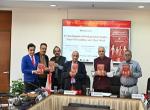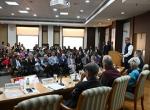The Indian Council for Cultural Relations (ICCR) organized the visit of the second batch of Gen-Next Democracy Network Programme from 20th May to 29th May 2022 with delegates from Peru, Bangladesh, Nepal, Ghana, and Brunei. The delegates visited the Vivekananda International Foundation on May 23rd 2022 for a roundtable discussion/lecture on different aspects and dimensions of Indian democracy.
Opening remarks were given by Dr Arvind Gupta, Director VIF, during which he introduced the speakers and also welcomed the esteemed delegation of young leaders. Emphasizing on India’s 75 years of independence, Dr Gupta highlighted that since its independence 75 years ago India had made significant progress as a democracy and as a highly diverse country. He further noted that although India had always been a contributor to the world by way of its ideas which is reflected in its philosophy, the pride in Indian culture and philosophy was lost along the way which it is now trying to recover.
In the course of the next one hour, there were discussions held on a variety of aspects of Indian democracy ranging from
- Socio-economic development and democracies presented by Professor Sujit Dutta, Distinguished Fellow & Editor – National Security, VIF;
- India’s cultural heritage discussed by Professor Dr. (Ms.) Shashiprabha Kumar, Distinguished Fellow, VIF;
- Military in a democracy presented by Naval Jagota, Senior Fellow, VIF; and
- India’s relations with its neighbors in South Asia discussed by Dr Sreeradha Datta, Centre Head and Senior Fellow, Neighbourhood Studies, VIF.
In the context of socio-economic development and democracy, Professor Dutta highlighted that India’s democratic journey goes way back to the 1820s-1830s onwards. The country always wanted a democratic path of development. However, India fell prey to colonization which left it in a miserable state so much so that India had to re-start its democratic journey post-independence with extremely poor economic status. And India since then has achieved a lot. It glorifies concepts such as diversity, freedom, and democracy and allows protests and opposition. It gave universal adult franchise to both men and women from the very beginning. In terms of economy, in the initial stages of post-independence era, India chose a state led economic model which was also a closed model. So, till 1991, India’s economy was very inward-looking. In 1991 it opened its economy which led to the second phase of the country’s history in economic terms where India started to gradually increase its engagement with the world opening up to foreign direct investment. During this period, India’s welfare side management was done through the public distribution system which meant food subsidy, opening up of many government schools to provide free education, and opening up of several government hospitals to provide free medical care. Referring to a recent study by the IMF, Professor Dutta highlighted an important argument from the paper which questions the methodology applied by the World Bank in terms of assessment of poverty in India which has always been on the higher side, as such, institutions and other Western writings do not take into consideration one of the most important factors in assessing poverty in India which is the role of subsidies in food and the role of transfer of income through goods and in kind rather than cash. In fact, the present government of India has insisted on expanding the welfare side in a massive way and many important steps have been taken to turn this into a reality. The truth lies in the fact that the Indian democracy is an achievement in sustaining democracy, ushering in industrialization rapidly and thereafter providing welfare to its people to overcome poverty.
The next presentation was made on India’s cultural heritage by Professor Shashiprabha Kumar. According to her, the Indian culture consists of certain unique features and through this discussion Professor Kumar intended to highlight few of the foundational elements of the Indian culture which are universal in character and could provide a strong and solid base for a new world order. Indian culture has been molded in a special manner in the sense that since time immemorial the Vedas has been its life and force. They are the source as well as sustaining force for all the subsequent systems of Indian culture. They are the fountainhead for Indian thought. Vedas constitute the core of Vedanta and the latter signifies an inner continuity of culture right from the Rigveda up to modern times. The heart and soul of this continuity of Indian culture is to be found in a constant intuition of unity of all life. It is this Vedic unitive vision which is one of the foremost foundations of Indian culture and provides an insight into the underlying unity of all phenomena which leads to a perception of all things in self and self in all things. In fact, Professor Kumar emphasized that this unity vision is so well engraved in Indian mind that it ignores or discards nothing of human experience. Indian cultural heritage does not discriminate between genders rather it presents a model of participatory and complementary roles for both of them in family and in society. Additionally, Indian mythology does not envisage any antagonism between the sexes rather delineates a relation of total identity or inseparability. Human equality as we all know is a mark of civil society and civil society demands respect for human rights but Indian culture has never been rights oriented rather it has been duty oriented. Another striking feature of Indian cultural heritage is the genuine concern for nature and environment. Dr Kumar concluded by saying that although generations after generations these inherent foundations of Indian culture may have altered in form and fashion but the direction and objective has remained intact.
The next lecture was given by Naval Jagota, Senior Fellow at Vivekananda International Foundation. His talk focussed on the role of military in a democracy. The Indian Constitution’s framework has ensured that the civilian authority was superior to the armed forces by making the President, a non-military official the commander-in-chief of the armed forces. Additionally, an oath is the bedrock of a true military professional and in the Indian context, earlier; the oath was based on the concept of ‘true to your salt’. However, now the oath is to the Constitution of India. Another feature of the Indian Armed Forces has been its total apolitical outlook. The Indian Armed Forces have stuck to the loyalty to the constitutionally elected government. Hence, the Indian Armed Forces have contributed to the political stability of the nation and enabled it to develop its unique democratic political ambience. The primary mode through which the Indian Constitution regulates the use of Armed Forces is by distinguishing between the military powers and law and order powers. The second mode through which the use of Armed Forces is regulated is through legislation and the third mode through which the Constitution regulates Armed Forces is by distinguishing between ordinary and emergency situations. India’s spending on defence has reduced and at present is 2.1 percent of its GDP while China spends three and half times more than India and Pakistan spends 4 percent of its GDP on defence. Despite these circumstances, the military in India is seen with respect and as upholder of the Constitution by the masses. The speaker concluded by saying that for a democracy to be vibrant and thriving as it is in India, there is a continuous need for vigilance, participation, engagement which leads to a dynamic and relevant policymaking. He further added that in order to ensure all organs of government and elements of society perform the role they have been assigned the ultimate guardian is the individual voter and this truth is imbibed and continuously reinforced in the military.
The last discussion was based on India’s relations with its South Asian neighbours by Dr Sreeradha Datta, Centre Head and Senior Fellow, Neighbourhood Studies, VIF. Starting with the geographical context, Dr Datta explained the land border and maritime border situation with its neighbours. India shares land borders with six of its South Asian neighbours which are Pakistan, Nepal, Bhutan, Afghanistan, Bangladesh, Myanmar, and seven if China is included. Additionally, it shares two maritime borders with Sri Lanka and Maldives. In terms of economy, earlier in the region it was India which was considered as the largest economy of the region, however, in today’s context in Asia it is China, then India, Bangladesh, Nepal who are doing well in terms of economy. An interesting aspect of the South Asian region is that despite the political differences there is a large overlap of cultural links across each other. For instance, both India and Nepal till today maintain an open-door policy. Additionally, India’s Neighbourhood First Policy has led it to engage deeply with its neighbours. Starting from 2014 when the present government took over, for the swearing in ceremony the chief guests were all South Asian neighbouring countries’ leaders. Similarly, in 2019 for the swearing in ceremony the BIMSTEC leaders were invited. These points bring to another important assertion made by Dr Datta which is that although such developments were taking place in the past, the kind of focussed momentum that was given in reaching out to the South Asian neighbours and to the people was something very different. There also some questions being raised about the integration of the South Asian region. In this regard, India has taken a lead by investing heavily in the neighbourhood. Another feature of the neighbourhood is that there is a thrust in ensuring that the regional environment should be worked on. It is also interesting to note that sub-regionalism is seen emerging within the region. There is a focus to integrate South Asian economies and Southeast Asian economies. In the Indian context, it plays the role of first responder in the neighbourhood whether in terms of humanitarian relief, disaster management, financial bailout, and refugees. The speaker concluded by saying that in the years to come both with the hard infrastructural development that India is doing as also with the progress in the areas of soft power, there would be a different South Asia and a very effective regionalism in the days to come.
Closing remarks were then given by Dr Arvind Gupta who highlighted the strengths of Indian democracy. He pointed out that despite problems such as cross-border terrorism, poverty, insurgencies, India collectively is doing fine and has adopted a democratic system of governance.
The session then continued with a long question and answer session.







Post new comment